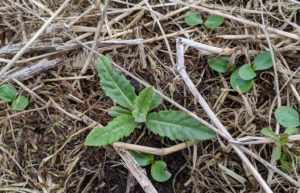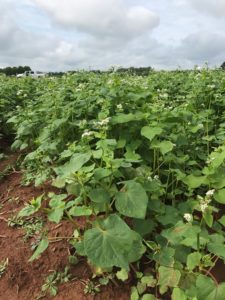Spring is here and with it comes the emergence of weeds- especially problematic perennials like Canada thistle (Figure 1). Below is some information about Canada thistle and methods to manage it. Keep in mind two things: 1) many of these strategies will work for other perennial weeds, and 2) management of perennial weeds often requires persistence and an integrated approach.
Scientific name: Cirsium arvense (L.) Scop.
Legal status: Canada thistle is considered a noxious weed in 46 states including Indiana. It is a non-native invasive species from Europe, and landowners with Canada thistle on their property are obligated to take measures to control it.
Growth habit: Deep-rooted and colony-forming perennial. Plants form a low-growing rosette in the spring prior to bolting in mid-to-late May.
Reproduction: By seeds carried up to 1/2 mile by wind and through adventitious shoots that develop from root buds.
Control: Often multiple types of control measures are needed. Consider a combination of the following:
- Exclusion and sanitation: Avoid spreading thistle roots, shoots, and seeds by cleaning tillage and mowing equipment between fields. Control Canada thistle in roadsides, field roads, and fencerows. Use tested seed. If you bring hay on-farm, use a reliable source.
- Crop rotation: Crop rotation can be a good option for controlling problematic weeds in vegetables. Rotate to row crops or other vegetable crops that are more competitive and have registered and effective herbicides.
- Herbicides: There are essentially two herbicide strategies. Many herbicides registered in vegetable crops may burn back the top growth of the weed, but do very little to suppress the extensive root system. This type of herbicide application is sometimes referred to as a “chemical mowing”. A second option is to use effective systemic herbicides. Two with good efficacy are glyphosate (ie. Roundup) and clopyralid (ie. Stinger). At the moment, clopyralid is labeled for use in these crops: beet, broccoli, Brussels sprouts, cabbage, cauliflower, collards, kale, kohlrabi, mint, mustard greens, spinach, sweet corn, Swiss chard, turnips, and turnip greens. With the exception of glyphosate-resistant sweet corn, its use in vegetables is limited to preplant burndown and some directed or spot-applications. For instructions on how to use each, consult the Midwest Vegetable Production Guide (https://mwveguide.org/) and the product label.
- Mowing: Mowing just before flower buds open can stop the development of Canada thistle seeds. However, timing is critical as viable seeds can be produced within 8 to 10 days after flowers open. Using multiple mowings, one at bud stage and one targeted toward fall regrowth, will help deplete root energy reserves.
- Cultivation/plowing: Use caution when using tillage around Canada thistle. Standard, light tillage will cut the roots into fragments and move them throughout the field. Tillage is not a stand-alone treatment. If tillage is used as the primary method of control, it should be done often and deeply to deplete root reserves. Do not use tillage prior to applying systemic herbicides, which could reduce their efficacy.
- Cover crops: There is some evidence that shows cover crops can be useful for suppressing Canada thistle growth. Cool-season crops like cereal rye can be planted in the late summer/early fall and will compete with Canada thistle as it emerges in spring. Warm-season cover crops used to suppress Canada thistle include sorghum-sudangrass and buckwheat (Figure 2). Sorghum-sudangrass has the added advantage that it benefits from mowing, whereas mowing is detrimental to Canada thistle.
- Biological controls: There are limited options. Although some insects feed on foliage, stems, crowns, and developing seeds, control is often highly variable. Delayed tillage and no-till have the added benefit of keeping seeds at or near the soil surface where they can be consumed by birds, rodents, and insects.

